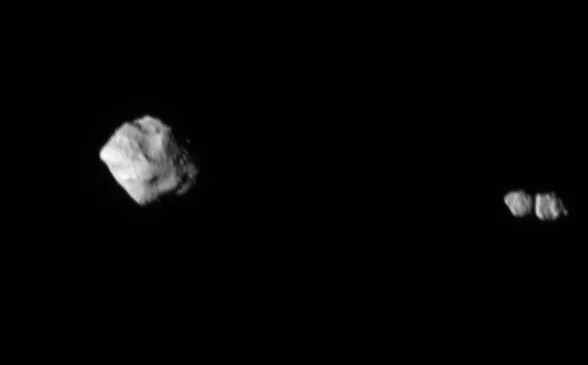Earlier this month, NASA’s Lucy probe completed its first flyby of the asteroid Dinkinesh, discovering that it actually was part of a binary pair with a smaller asteroid satellite orbiting it. Now, though, the probe has revealed even more information about Dinkinesh. It isn’t just the larger asteroid that is part of a binary pair. Dinkinesh’s unanticipated satellite is actually a contact binary itself.
According to a new post shared by NASA, the data captured by Lucy’s Long-Range Reconnaissance Imager (L’LORRI), Dinkinesh’s smaller satellite is actually made up of two smaller objects touching each other. The reason that this wasn’t seen before, when the first satellite was discovered, is because the two asteroids were lined up perfectly, hiding one behind the other.
Contact binaries are relatively common within our solar system, John Spencer, Lucy’s deputy project scientist of the Boulder, Colorado branch of San Antonio’s Southwest Research Institute, shared in the NASA post. However, I don’t think anyone expected to find evidence of one during Lucy’s first flyby of an asteroid like Dinkinesh.

Spencer continued, “We haven’t seen many up-close, and we’ve never seen one orbiting another asteroid. We’d been puzzling over odd variations in Dinkinesh’s brightness that we saw on approach, which gave us a hint that Dinkinesh might have a moon of some sort, but we never suspected anything so bizarre!”
The discovery of this additional contact binary during Lucy’s Dinkinesh flyby is both exciting and puzzling. Scientists are already confused about why the two components of the satellite are similar sizes, as well as how they came to join together the way they have. Perhaps we’ll see future research that will help us understand that.
Lucy’s flyby of Dinkinesh was just the start, of course. The probe will now continue its mission deeper into our solar system, capturing data and images of other asteroids as it does. The second photo, which revealed the second component of the satellite, was taken roughly 960 miles beyond where the first was taken, showcasing just how important perspective is to the data we capture about our universe.








